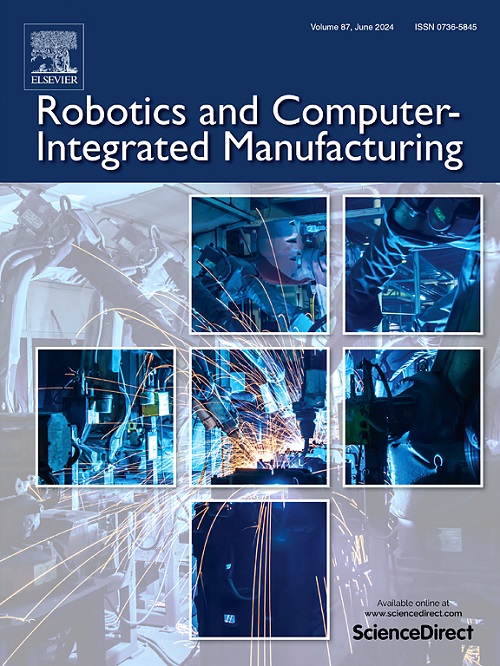Iterative offline trajectory correction based on dynamic model for compensating robot-dependent errors in robotic machining
IF 11.4
1区 计算机科学
Q1 COMPUTER SCIENCE, INTERDISCIPLINARY APPLICATIONS
引用次数: 0
Abstract
As manufacturing demands shift towards enhanced part geometries and materials, the need for flexibility in production has driven interest in robotic machining. This fast-growing technology offers advantages like cost-effectiveness, adaptability, and easy deployment, making it suitable for agile production lines. However, robotic machining encounters accuracy challenges due to inherent robot flexibility, causing deviations and vibrations.
The positioning error along a robotic machining trajectory is composed of two contributions: the steady-state error and the transient. This research addresses these challenges through compensation methods based on a robotic cell equipped with a Stäubli TX200 and its digital shadow. By proposing trajectory corrections based on the results from virtual machining simulator including the robot dynamical model, the study aims to compensate the static and dynamic deviations, responsible for steady-state and transient errors respectively. To achieve this, the trajectory is discretised in elementary sections, modelled with Hermite splines and connected by nodes that are iteratively repositioned in space based on the error estimated from the dynamics simulation and weighted along the tool path.
Simulations and experiments are carried out in Aluminium 6082 to demonstrate the gain of iterative compensation algorithm. The error reduction encountered in simulation is successfully confirmed in experimental cases, within the repeatability tolerance of the robot, decreasing the steady-state error by 90% and about 60% in transient phases.
机器人加工中基于动态模型的轨迹迭代离线修正补偿机器人相关误差
随着制造需求转向增强零件几何形状和材料,对生产灵活性的需求推动了对机器人加工的兴趣。这种快速发展的技术提供了诸如成本效益、适应性和易于部署等优势,使其适合敏捷生产线。然而,由于机器人固有的灵活性,机器人加工面临精度挑战,导致偏差和振动。
本文章由计算机程序翻译,如有差异,请以英文原文为准。
求助全文
约1分钟内获得全文
求助全文
来源期刊
CiteScore
24.10
自引率
13.50%
发文量
160
审稿时长
50 days
期刊介绍:
The journal, Robotics and Computer-Integrated Manufacturing, focuses on sharing research applications that contribute to the development of new or enhanced robotics, manufacturing technologies, and innovative manufacturing strategies that are relevant to industry. Papers that combine theory and experimental validation are preferred, while review papers on current robotics and manufacturing issues are also considered. However, papers on traditional machining processes, modeling and simulation, supply chain management, and resource optimization are generally not within the scope of the journal, as there are more appropriate journals for these topics. Similarly, papers that are overly theoretical or mathematical will be directed to other suitable journals. The journal welcomes original papers in areas such as industrial robotics, human-robot collaboration in manufacturing, cloud-based manufacturing, cyber-physical production systems, big data analytics in manufacturing, smart mechatronics, machine learning, adaptive and sustainable manufacturing, and other fields involving unique manufacturing technologies.

 求助内容:
求助内容: 应助结果提醒方式:
应助结果提醒方式:


